An AP who wants to edge sort in baccarat is like a Sumo wrestler who wants to perform ballet: just because he wants to do it does not mean it is possible. In most baccarat games, the player doesn’t touch the cards. When the player is allowed to turn over the cards, it is usually done with the finesse of a drunken elephant; the cards rarely survive the ordeal. In many casinos, pre-shuffled shoes are brought into play. In the situation where the cards are re-used, getting the cards to be correctly oriented is yet another challenge. After all that, if somehow the shoe does get sorted, if the shuffle includes a turn then an edge sorting scheme will unilaterally fail. Then there is the final obstacle: how can edge sorting possibly work if the AP can’t see the first four cards before placing his bet?
In spite of this long list of challenges, I know of two documented cases where advantage players pulled off this remarkable feat. The key point is that high-rollers negotiated to have the first four cards dealt before they placed their wagers. They also negotiated with the house to have the dealer rotate the cards for them, so that the high and low groups were oriented in opposite orientations. Without casino management understanding why the high-rollers were making their odd requests, the lure of the high-roller’s big play was reason enough to acquiesce.
If you need a reminder about edge sorting, it is covered in this blog post. Edge sorting requires that the cards be sorted into two groups, with the defect along the edges (or corners) oriented to allow quick identification of the group to which each card belongs. In baccarat, the two groups that work best are the “low cards” which is the subset {T, A, 2, 3, 4, 5} and the “high cards” which is the subset {6, 7, 8, 9}. The point of this division is that the high cards are most likely to not require a draw of a third card when dealt. In particular, the grouping of a high card with a low card usually forms a powerful hand.
Here is a picture illustrating how the sort looks:
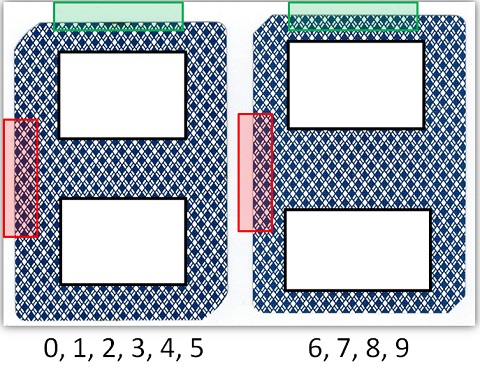
Here is the combinatorial analysis. In this table, “H” stands for a card from the high group and “L” stands for a card from the low group.
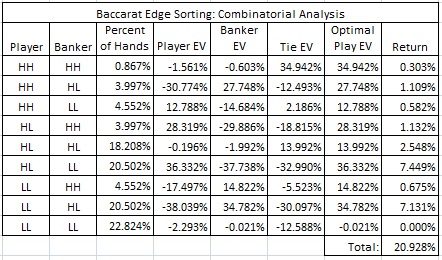
Note that the average edge the advantage player has over the house is 20.928%. This is a tremendous advantage, especially given the low volatility of this scheme. The single most profitable move is to bet on the player side when the player has the group HL and the banker has the group LL. This situation occurs on 20.502% of the hands played, and the AP has a 36.332% advantage. There is one situation where there is no profitable wager, namely, when both the player and banker sides show the group LL. This happens on 22.824% of the hands. In two situations, the only profitable move is to wager on the tie bet. This happens on about 19.075% of the hands.
The following table gives optimal edge sort strategy for baccarat:
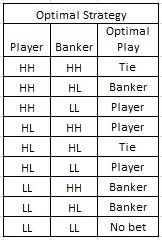
The following picture illustrates the situation HL vs. HH (Player = 0,9, Banker = 8,6), with a 28.319% edge by betting on Player:
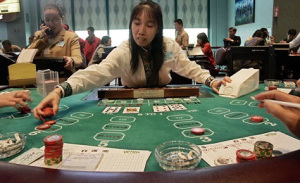
Another way that edge sorting can take place is if, after the shoe is sorted, only the first card is observed before the wager is made. This can occur when the first card is visible in the shoe, as shown in this picture:
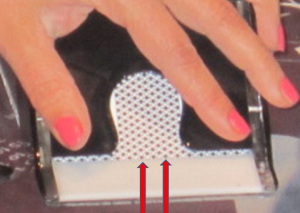
I discuss this situation, which is equivalent to knowing the hole card, in my article on the known card in baccarat. In this situation, the player has a 6.765% edge over the house.
There are a number of ways casino management can protect the game of baccarat from an edge sorting vulnerability. The easiest solution is to use a shoe once and then discard it. If this is not a cost-feasible solution, then:
- Include a turn in every shuffle.
- Require that all wagers are placed before the cards are dealt.
And yes, there ARE Sumo ballerinas.


